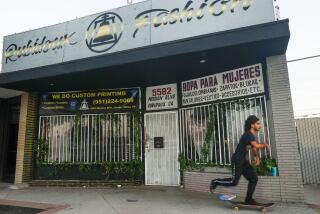Once Again, to Be Black Is to Be a Suspect
“Give me 357 reasons to blow your brains out.”
Edison Robinson says that’s what the cop told him. He was lying with his face to the ground. The officer had his gun--presumably a .357 magnum--pointed at the back of Robinson’s head.
This was South-Central, 1988. The location was 59th and Budlong, outside a friend’s house. Robinson had come by to see a newborn baby when the approaching officers, weapons drawn, ordered him to the ground. They were searching for a gunman who had taken a shot at a police officer. The suspect was described as a black man wearing a black Kangol shirt--a popular brand that features the image of a kangaroo.
Robinson is black; he was wearing such a shirt. He was detained a matter of minutes, he says, until a black detective arrived and said no, it wasn’t him.
His anger builds as he tells the story. We’re sitting inside Mama Rosie’s Down Home Cooking on Winnetka Avenue in Canoga Park, where Robinson is the manager. This is the San Fernando Valley, 1993. Now the police are aggressively hunting for a suspect who has been dubbed the Valley Molester. He’s a black guy too; police composites show a man with a mustache.
For a while, police thought they had their man. But on Tuesday, after four days in jail, a tearful James Elliot Singletary walked out a free man, having been exonerated of suspicion in acts against more than 30 children, including the rape of an 8-year-old girl.
Singletary is a 45-year-old Encino resident who wears a beard. Robinson is a 42-year-old Canoga Park resident who wears a mustache.
Early Wednesday morning, police detained Robinson again. Just asked him a couple of questions and let him go.
*
Robinson didn’t like it. “I guess they’ve got to do that to every black man they see,” he said bitterly.
This is not a new story. It is sometimes said that to be a black man in America is to be a permanent suspect. However much that is true, people like James Singletary and Edison Robinson would say that it is especially true today in the Valley amid public outcry for the arrest of a serial molester.
You might think that the Valley branch of the NAACP is being flooded with complaints. If so, you would be wrong, according to the Rev. Zedar E. Broadous, branch president.
“No, not many complaints,” Broadous says. “Most people are aware of the seriousness of the complaints and understand. . . .
“I don’t know too many people who today, if they saw someone around a school who looked suspicious, wouldn’t call the police. So now there are more calls than ever about a black man around an elementary school. If the perpetrator was a Caucasian, you’d have more calls than ever about a Caucasian around a school.”
The problem is that there are more times and places when “looking suspicious” is the same as being black. The other day, police detained one suspect and put him in handcuffs near a school. A small crowd gathered. If this was the infamous molester, he seemed fairly cool about his predicament. “They have a job to do,” the man said of the police. Two hours later, he was released.
As Broadous suggests, there might be more anger but for the nature of these crimes. Civil liberties often take a back seat when the victims are children. This can have unfortunate consequences, as in the numerous instances of people wrongfully accused of child molestation. But the risk is deemed worthwhile.
Ricky Williams, 33, is another African American who roughly fits the suspect’s description. Williams, who lives in Lancaster, empathizes with the parents on his postal route in Van Nuys. He’s all for aggressive policing to catch the suspect; after all, he’s a father of three himself.
“Whatever it takes,” Williams says.
*
Police composites are another source of Edison Robinson’s anger. A bulletin describes the suspect as at least 5 feet, 10 inches tall; Robinson is 5 feet, 7 inches. It may seem a bit much to quibble over three inches, but perhaps Robinson has 357 reasons.
Broadous understands. Twenty years ago, the LAPD held him overnight as a homicide suspect. “They showed me the composite drawing of a guy and the guy looked exactly like me,” he says. “But there’s no way in the world that I killed a highway patrolman, his wife and two children.”
Broadus expresses the faith that Chief Willie L. Williams and community policing are reasons for optimism. But meanwhile, the NAACP, he says, has received some discouraging calls recently--though not on the molester case. These came from white people venting anger about the outcome of the Reginald O. Denny beating trial.
More to Read
Sign up for Essential California
The most important California stories and recommendations in your inbox every morning.
You may occasionally receive promotional content from the Los Angeles Times.










